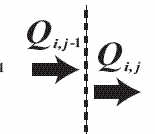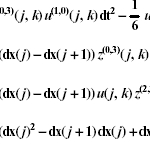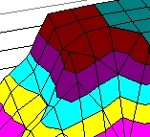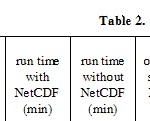Technical Reports In this space, we have made available several technical reports produced by members of the Hydrodynamic Modeling group. Papers are presented in reverse chronological order. These PDF files require the Adobe Acrobat Reader. | |
 |
TechReport0601.pdf 135 KB - 11/06/06 J.C. Dietrich, R.L. Kolar, K.M. Dresback "Derivation of a Consistent Flux for the Generalized Wave Continuity Equation (GWCE) in One Dimension" EM/GIS Report No. 06-01. Environmental Modeling / GIS Laboratory, School of Civil Engineering and Environmental Science, University of Oklahoma, Norman OK 73019 ABSTRACT: "Derivation of fluxes for use in mass balance computations that are consistent with the finite element discretization of the GWCE." |
 |
TechReport0402.pdf 81 KB - 07/20/04 K.M. Dresback, R.L. Kolar "Truncation Error Analysis for ADCIRC" EM/GIS Report No. 04-02. Environmental Modeling / GIS Laboratory, School of Civil Engineering and Environmental Science, University of Oklahoma, Norman OK 73019 ABSTRACT: "Herein, we examine the truncation errors for the governing equations of ADCIRC (GWC, NCM and CM equations). To evaluate the truncation errors, we utilize Taylor series expansions for all the terms in the governing equations. By using the Taylor series, we expand the dependent variables around a common point for evaluation purposes. After using the Taylor series to expand out the dependent variables in the equations, the results are subtracted from the continuous equations in order to obtain the truncation error. The discrete form of the equations come from using linear finite element for the spatial discretization and a two time level scheme centered at for the temporal discretization (a Crank-Nicholson scheme). The nonlinear terms in the equations employ an explicit formulation. We utilize the exact quadrature rules and averaged terms are based on an elemental average. In the evaluation of the truncation errors, we employ Mathematica® to expand the Taylor Series to the seventh order terms; however, we report errors only to the first two orders of errors. From these truncation errors, we determined that the GWC equation is first-order accurate in time if the advective terms are in non-conservative form, while it is second-order accurate in time if the advective terms are in conservative form. In space, the GWC equation is first-order accurate for variable spacing; while, it is second-order accurate for constant spacing. For the NCM and CM equations, we found that they are first-order accurate in time and space if we use variable spacing while it is second-order accurate in space if we use constant spacing. Also, both momentum equations become second-order accurate in time if the equations are linearized." |
 |
TechReport0401.pdf 483 KB - 05/17/04 J.C. Dietrich, R.L. Kolar, R.A. Luettich "Assessment of ADCIRC's Wetting and Drying Algorithm" EM/GIS Report No. 04-01. Environmental Modeling / GIS Laboratory, School of Civil Engineering and Environmental Science, University of Oklahoma, Norman OK 73019 ABSTRACT: "The ADvanced CIRCulation (ADCIRC) model is a finite-element hydrodynamic model based on the generalized wave continuity equation (GWCE). The model assumed fixed land boundaries until a wetting and drying algorithm was implemented by Luettich and Westerink in 1995. The algorithm uses an element-based approach, effectively turning elements on and off based on water depths and a water level gradient. While robust in some simulations, the algorithm can be subject to instabilities in the solution during highly nonlinear events. Thus, a rigorous assessment of the algorithm's stability, accuracy, mass balance properties, and parameter sensitivity under a variety of conditions is needed. Herein, we examine these issues using a one-dimensional implementation of the wetting and drying algorithm for basins with a linear slope; future studies will examine a wider variety of real and idealized basins. We believe the results of this work will benefit similar studies in two- or three-dimensions, for users and developers of both ADCIRC and other finite element models." |
 |
TechReport0301.pdf 99 KB - 12/01/03 K.M. Dresback, R.L. Kolar, J.C. Dietrich, E.P. Gilje. "Benchmarking of the ADCIRC Hydrodynamic Model on Workstation Clusters" EM/GIS Report No. 03-01. Environmental Modeling / GIS Laboratory, School of Civil Engineering and Environmental Science, University of Oklahoma, Norman OK 73019 ABSTRACT: "This report presents the results of a series of benchmarking tests conducted using the parallel version of the ADCIRC hydrodynamic model. In particular, these tests compared the performance of the original version of the ADCIRC model against that of a similar version that includes a predictor-corrector (implicit) time-stepping algorithm. As will be shown, the enhanced stability of this new algorithm allows simulations to be completed in less wall-clock time, without a decrease in scalability. We benchmarked these two versions of the model on two 16-processor workstation clusters: one consisting of Sun UltraSparc IIe processors, and another consisting of Intel Pentium III processors. Results indicate that the predictor-corrector algorithm provides the same enhanced stability in parallel that it does in serial, allowing for larger time steps and shorter wall-clock times. Results also indicate that the two platforms show similar performance, though the Intel platform is slightly better in some instances." |
 |
TechReport0201.pdf 81 KB - 12/01/03 E.P. Gilje, R.L. Kolar, K.M. Dresback, J.C. Dietrich. "Improving Performance of the ADCIRC Hydrodynamic Model" EM/GIS Report No. 02-01. Environmental Modeling / GIS Laboratory, School of Civil Engineering and Environmental Science, University of Oklahoma, Norman OK 73019 ABSTRACT: "This project’s goal is to improve performance of the ADCIRC hydrodynamic Model. Two main areas of research were conducted. The first area involved a benchmarking study on a Linux cluster. These results were then compared to benchmarking results from a SUN cluster. To get a complete view of ADCIRC’s performance both the job size and number of processors being used were varied both individually and simultaneously. By doing this conclusions were able to be drawn about the communication costs between processors, the effect of cache, as well as how the type of grid effects the ADCIRC run. The second area of research tried to further enhance the efficiency of ADCIRC by adding the NetCDF file type to ADCIRC. Results from this led to conclusions about how much time and space could be saved by ADCIRC by using different file types." |